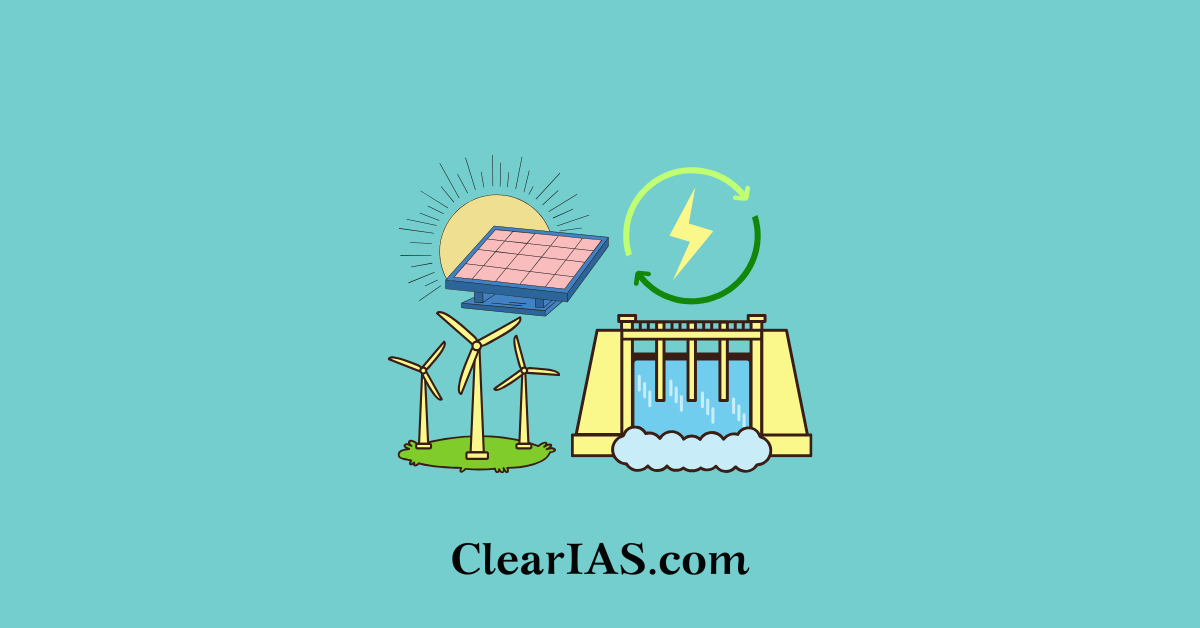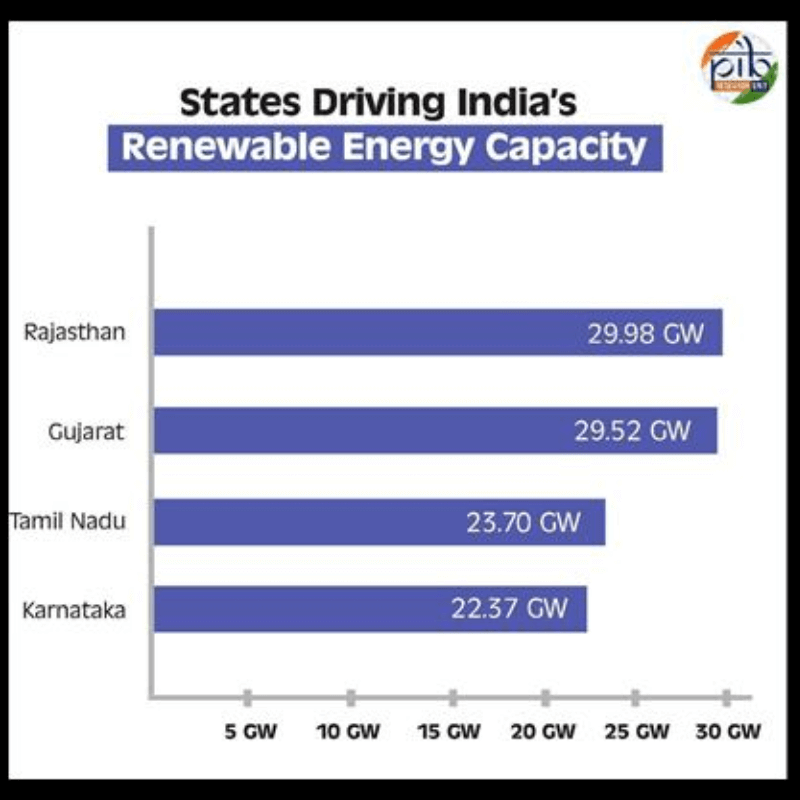
India’s renewable energy journey has reached a notable milestone, with the total installed capacity surpassing 200 GW. This marks a crucial step toward the nation’s 500 GW non-fossil energy target by 2030. This achievement underscores India’s commitment to sustainable development and combating climate change. Read here to learn more.
As a rapidly developing nation, India has significant potential for renewable energy (RE) generation, which aligns with its commitments under the Paris Agreement and its target to achieve net-zero carbon emissions by 2070.
With abundant natural resources and advancing technology, India has become a global leader in renewable energy deployment.
Renewable energy in India
- Solar Power: The largest contributor, with rapid installations under large-scale solar parks and rooftop solar systems.
- Wind Power: Second largest, particularly in states like Tamil Nadu, Gujarat, and Maharashtra.
- Hydropower: A steady contributor to the renewable energy mix.
- Biomass and Other Sources: Supporting cleaner energy solutions, especially in rural and industrial areas.
Renewable Energy Sources and Potential
- Solar Energy
- Potential: ~748 GW
- Reasons: High solar insolation (4-7 kWh/m²/day) and over 300 sunny days annually.
- Developments:
- India ranks among the top countries in solar power capacity.
- Solar parks like the Bhadla Solar Park in Rajasthan are examples of India’s large-scale solar projects.
- Initiatives: National Solar Mission and Solar Rooftop Program.
- Wind Energy
- Potential: ~302 GW (at 100-meter hub height).
- Key States: Tamil Nadu, Gujarat, Maharashtra, Karnataka, and Rajasthan.
- Developments:
- Onshore wind power is well-developed, while offshore wind is an emerging focus.
- Initiatives: National Offshore Wind Energy Policy.
- Hydropower
- Potential: ~148 GW (Large and small hydro combined).
- Key Regions: Himalayan states (Jammu & Kashmir, Himachal Pradesh, Uttarakhand) and Northeastern states.
- Small Hydro: Focused on decentralized power generation.
- Biomass Energy
- Potential: ~25 GW.
- Sources: Crop residues, animal waste, and agro-industrial by-products.
- Importance: Provides power for rural areas and reduces waste.
- Geothermal Energy
- Potential: ~10 GW.
- Key Sites: Puga Valley (Ladakh), Tattapani (Chhattisgarh), and Manikaran (Himachal Pradesh).
- Challenges: High upfront costs and technological gaps.
- Tidal and Wave Energy
- Potential: Tidal (~12 GW) and Wave (~40 GW).
- Key Regions: Gujarat and Sundarbans are used for tidal energy; Kerala and Tamil Nadu are used for wave energy.
- Challenges: High costs and limited pilot projects.
Leading States in Renewable Energy Capacity

Several states in India have emerged as leaders in renewable energy capacity, contributing significantly to the nation’s progress.
- Rajasthan tops the list with an impressive 29.98 GW of installed renewable energy capacity, benefiting from its vast land and abundant sunlight.
- Following closely is Gujarat, which boasts a capacity of 29.52 GW, driven by its strong focus on solar and wind energy projects.
- Tamil Nadu ranks third with 23.70 GW, leveraging its favourable wind patterns to generate substantial energy.
- Karnataka rounds out the top four with a capacity of 22.37 GW, supported by a mix of solar and wind initiatives.
Global Leadership
India’s commitment to addressing climate change is reflected in its enhanced Nationally Determined Contributions (NDCs) under the Paris Agreement, incorporating the five elements outlined at COP26 in Glasgow.
- These efforts align with the principles of equity and Common but Differentiated Responsibilities and Respective Capabilities (CBDR-RC), considering national circumstances.
- As part of the updated NDC submitted to the UNFCCC (United Nations Framework Convention on Climate Change) in August 2022, India has committed to reducing its emissions intensity by 45% by 2030 (compared to 2005 levels), achieving 50% of cumulative electric power capacity from non-fossil fuel sources by 2030, and promoting a sustainable way of living through the ‘LIFE’ (Lifestyle for Environment)
- These targets also contribute to India’s long-term goal of reaching net-zero emissions by 2070, supported by the ‘Long-term Low Carbon Development Strategy ‘ submitted to the UNFCCC in November 2022.
- India ranks among the top three renewable energy markets globally, showcasing its proactive policies and market dynamics.
- The country plays a pivotal role in global clean energy initiatives, such as the International Solar Alliance (ISA) and One Sun, One World, One Grid.
Government Initiatives and Targets
- Nationally Determined Contributions (NDCs):
- Achieve 50% of installed power capacity from non-fossil fuel sources by 2030.
- Reduce the emissions intensity of GDP by 45% from 2005 levels by 2030.
- Renewable Energy Targets:
- 175 GW by 2022 (achieved ~122 GW by the deadline).
- 500 GW by 2030 from non-fossil fuel sources.
- Policies and Missions:
- National Solar Mission.
- National Wind-Solar Hybrid Policy.
- Production-Linked Incentive (PLI) Scheme for domestic manufacturing of solar cells and modules.
- Other Government Initiatives:
- Schemes like the PM-KUSUM Yojana, investments in solar manufacturing, and the Green Energy Corridor
Challenges in Harnessing Renewable Energy Potential
- Land Acquisition: Large-scale solar and wind farms require significant land resources. Identifying suitable sites and building necessary grid connections.
- Storage Technology: Intermittency of solar and wind energy necessitates efficient battery storage solutions. Scaling battery technologies to ensure round-the-clock availability of renewable power is necessary.
- Grid Infrastructure: Inadequate grid capacity to integrate renewable energy.
- Policy and Financing: Need for consistent policies and financial mechanisms to attract investments.
- Skilled Workforce: Lack of expertise in emerging technologies like offshore wind and geothermal.
Impact on Sustainable Development Goals (SDGs)
- Advances SDG 7 (Affordable and Clean Energy), SDG 13 (Climate Action), and SDG 8 (Economic Growth).
- Contributes to reducing India’s dependence on fossil fuels, aligning with the Paris Agreement and its Net Zero by 2070 goal.
Prospects for India
India’s renewable energy sector holds immense promise with the right blend of policy support, technological advancements, and public-private partnerships. This will not only ensure sustainable growth but also position India as a global leader in green energy.
- The global renewable energy workforce expanded to 16.2 million in 2023, up from 13.7 million in 2022, with India playing a significant role in this growth.
- In 2023, India added 9.7 GW of solar PV capacity, ranking fifth globally for new installations and cumulative capacity, which reached 72.7 GW by the end of the year.
- Of the total solar workforce, 238,000 jobs were in grid-connected solar PV, reflecting an 18% increase from 2022, while around 80,000 individuals worked in the off-grid solar sector.
- The wind sector employed about 52,200 people, with nearly 40% of these jobs in operations and maintenance and 35% in construction and installation.
- Other renewable energy subsectors also contributed to job creation, with liquid biofuels providing 35,000 jobs, solid biomass contributing 58,000 jobs, and biogas generating 85,000 jobs.
- Additionally, the solar heating and cooling sector employed 17,000 people, highlighting the diverse and expanding employment opportunities within India’s renewable energy industry.
Conclusion
India’s 200 GW milestone reflects not only progress in renewable energy but also a robust framework supporting a green transition that benefits both the environment and the economy.
The proactive initiatives such as the National Green Hydrogen Mission, PM-KUSUM, PM Surya Ghar, and the PLI schemes for solar PV modules underscore the government’s strategic focus on enhancing energy generation capacity while reducing reliance on fossil fuels.
With ambitious targets set for the future, including a goal of 500 GW from non-fossil sources by 2030, India is well-positioned to emerge as a global leader in renewable energy, contributing to environmental sustainability and energy security.
Frequently Asked Questions (FAQs)
Q. What is the current status of renewable energy in India?
Ans: India’s total electricity generation capacity has reached 452.69 GW, with renewable energy contributing a significant portion of the overall power mix. As of October 2024, renewable energy-based electricity generation capacity stands at 201.45 GW, accounting for 46.3 per cent of the country’s total installed capacity.
Related articles:
- Green energy partnerships of India
- Indian power sector
- Green hydrogen
- Energy Crisis: Causes and Global Impact
-Article by Swathi Satish






Leave a Reply